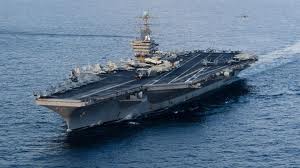 Deterring Iran is a delicate balance of diplomacy,�sanctions�and military muscle-flexing, all intended to send a strong signal � without proving so provocative that the region is pushed toward war. One piece of the effort � halting the proliferation of illicit weapons � got a practice run in the Persian Gulf this week.
Deterring Iran is a delicate balance of diplomacy,�sanctions�and military muscle-flexing, all intended to send a strong signal � without proving so provocative that the region is pushed toward war. One piece of the effort � halting the proliferation of illicit weapons � got a practice run in the Persian Gulf this week.Although the exercise did not explicitly name an adversary, geography certainly pointed to Iran, as well as to militants of Al Qaeda still operating in the region. The exercise, which ended Thursday, included a headquarters simulation to test the policy-making and coordination among the American military and two dozen nations that joined, as well as an extensive component of military drills at sea, in the air and on land.
Pentagon officials do not hide the fact that halting suspected smugglers, and boarding their vessels and inspecting them, is in some ways easier than knitting together a coalition of countries to operate under the decade-old�Proliferation Security Initiative.
While there may be quiet agreement that Iran is a threat to regional stability, many nations � especially Iran�s neighbors � want to avoid any appearance of belligerence that might make relations even worse. In fact, several of the countries in this week�s exercise declined to officially confirm their participation.
That alliance cohesion problem is not new. When the Proliferation Security Initiative was begun by the administration of President George W. Bush, South Korea initially refused to join, for fear of angering North Korea. The government in Seoul eventually reversed the decision, and South Korea is among the nonproliferation program�s current members, a number that has expanded to 102 nations from the original 11.
Separate from this current multinational exercise, American and Yemeni officials disclosed last week that a joint operation had�interdicted a boat carrying a large load of explosives and weapons, including shoulder-launched antiaircraft weapons. Intelligence indicated that the shipment came from Iran and was destined for Houthi insurgent militants inside Yemen.
Even before the proliferation exercise ended this week, the American military�s Central Command announced the scheduling of another exercise to practice mine countermeasures and maritime security in waters of the Middle East. Those skills would be necessary if Iran tried to close the Strait of Hormuz. More than 20 nations will participate in the exercise, set to begin in May.
But budget difficulties in Washington may make sustaining a large American military presence in the region more difficult. The Pentagon announced this week that, temporarily at least, there would be only one aircraft carrier strike group on patrol in the region, down from the usual two. The reason: the Defense Department needs to save money.
By The New York Times
The Iran Project is not responsible for the content of quoted articles.











